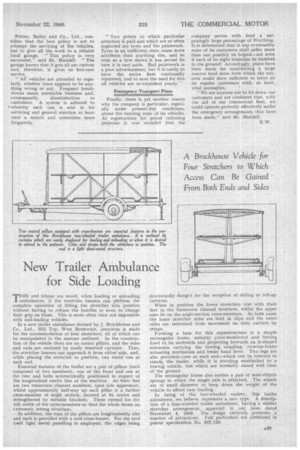New Trailer Ambulance for Side Loading
Page 31

If you've noticed an error in this article please click here to report it so we can fix it.
'T IME and labour are saved, when loading or unloading 1 ambulances, if the stretcher bearers can perform the complete operation of lifting the stretcher into position without having to release the handles or even to change their grip on them. This is more often than not impossible with end-loading vehicles.
In a new trailer ambulance devised by, J. Brockhouse and Co., Ltd., Hill Top, West Bromwich, provision is made for the accommodation of four stretchers, all of which can be manipulated in the manner outlined. In the construction of the vehicle there are no corner pillars, and the sides and ends are enclosed by easily removed curtains. Thus, the stretcher bearers can approach it from either side, and, while placing the stretcher in position, can stand one at each end.
Essential features of the trailer are a pair of pillars (each composed of two members), one at the front and one at the rear and both symmetrically positioned in respect of the longitudinal centre line of the machine. At their feet are two transverse channel members, open side uppermost, whilst approximately half-way up each pillar, is a further cross-member of angle section, secured at its centre and strengthened by suitable brackets. These extend for the full width of the cross-members so that the whole forms an extremely strong structure.
In addition, the tops of the pillars are longitudinally tied and each is provided with a roof cross-bearer. For the roof itself light metal panelling is employed, the edges being downwardly flanged for the reception of sliding or roll-up curtains.
When in position the lower stretchers rest with their feet in the transverse channel members, whilst the upper ones lie on the angle-section cross-members. In both cases the inner stretcher sides are held in clips and the outer sides are restrained from movement on their carriers by straps. Forming a base for this superstructure is a simple rectangular frame, suitably cross-membered and having fixed to, its underside and projecting forwards an A-shaped extension 'carrying the towing coupling, overrun-brake actuating mechanism and brake hand lever. Two legs are also provided—one at each end—which can be lowered to steady the trailer, while it is standing unattached to a towing vehicle, but which are normally raised well clear of the ground. . The rectangular frame also carries a pair of semi-elliptic springs to which the single axle is attached. The wheels are of small diameter to keep down the weight of the vehicle to afford easy loading.
In being of the two-wheeled . variety, this trailer ambulance, we believe, represents a new type. A description of a four-wheeled trailer ambulance, having a similar stretcher arrangement, appeared in our issue dated November 4, 1939. The design certainly possesses a number of attractions. Full particulars are contained in patent specification No. 527,133.




















































